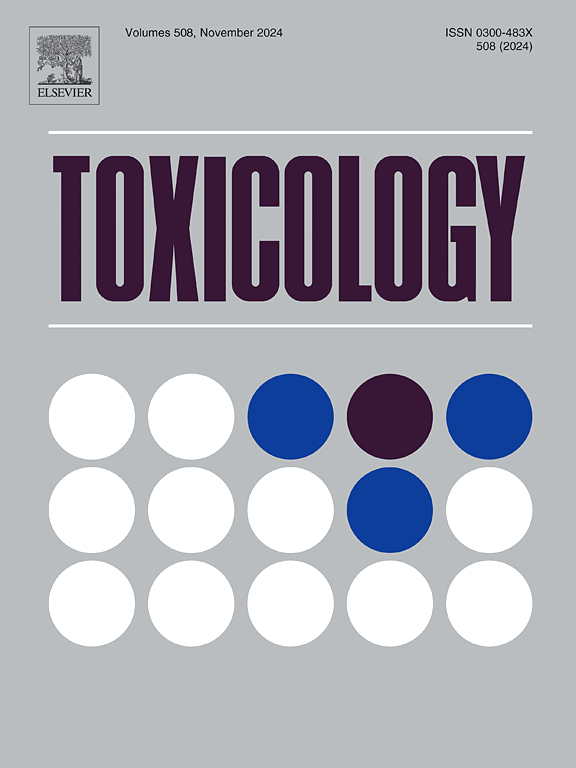锑通过氧化应激激活的JNK信号通路诱导胰岛β细胞线粒体依赖性和内质网应激触发的凋亡
IF 4.6
3区 医学
Q1 PHARMACOLOGY & PHARMACY
引用次数: 0
摘要
锑(Sb)是一种银白色金属,是一种特别普遍的重金属,通过自然过程和人类活动导致的环境暴露对人类产生不利影响。流行病学研究表明Sb与糖尿病(DM)发展的可能性有关。然而,Sb对胰岛β细胞的毒理学作用机制尚不清楚。在这项研究中,Sb暴露显著抑制大鼠胰岛β细胞来源的RIN-m5F细胞活力和胰岛素分泌,同时诱导线粒体依赖的凋亡信号,包括凋亡细胞群增加、caspase-3活性、PARP和caspase-3/-7/-9的表达以及线粒体功能障碍。RIN-m5F细胞暴露于Sb也通过诱导一些重要分子,包括CHOP、xbp -1和caspase-12,导致内质网(ER)应激的触发。在sb暴露的RIN-m5F细胞中,4-PBA预处理(内质网应激抑制剂)显著抑制内质网应激相关蛋白的表达和凋亡事件。此外,暴露于Sb会导致AMPKα、ERK1/2和JNK信号的显著激活,以及活性氧(ROS)的产生。用SP600125(一种JNK抑制剂)和抗氧化剂NAC,而不是PD98059(一种ERK抑制剂)或化合物C(一种AMPK抑制剂)进行预处理,可以有效地消除sb暴露大鼠胰岛β细胞的细胞毒性、内质网应激反应、线粒体功能障碍、凋亡事件、胰岛素分泌抑制和JNK激活。然而,SP600125并没有阻止ROS的产生,而是被抗氧化剂NAC所抑制。综上所述,结果表明Sb通过氧化应激激活的JNK信号下游调控的线粒体依赖和内质网应激触发的细胞凋亡途径发挥β-细胞的细胞毒性,最终导致大鼠胰岛β-细胞死亡。本文章由计算机程序翻译,如有差异,请以英文原文为准。
Antimony induces mitochondria-dependent and ER stress-triggered apoptosis via the oxidative stress-activated JNK signaling pathway in pancreatic islet β-cells
Antimony (Sb), a silvery-white metal, is a heavy metal of particular prevalence that has the ability to result in adverse effects in humans through environmental exposure resulting from natural processes and human activities. Epidemiological studies have suggested that Sb has an association with the potential for diabetes mellitus (DM) development. However, the mechanisms by which Sb exerts toxicological effects on pancreatic islet β-cells are still not clear. In this investigation, Sb exposure significantly inhibited rat pancreatic islet β-cell-derived RIN-m5F cell viability and insulin secretion, while inducing mitochondria-dependent apoptotic signals, inclusive of increased apoptotic cell populations, caspase-3 activity, the expression of PARP and caspase-3/-7/-9, and mitochondrial dysfunction. RIN-m5F cells exposure to Sb also led to the triggering of endoplasmic reticulum (ER) stress via the induction of a number of vital molecules, including CHOP, XBP-1s, and caspase-12. In Sb-exposed RIN-m5F cells, 4-PBA pretreatment (an inhibitor of ER stress) significantly suppressed protein expression related to ER stress and events of an apoptotic nature. Furthermore, exposure to Sb resulted in the significant activation of AMPKα, ERK1/2, and JNK signaling, as well as reactive oxygen species (ROS) generation. Pretreatment with SP600125 (an inhibitor of JNK) and antioxidant NAC, but not PD98059 (an inhibitor of ERK) or compound C (an inhibitor of AMPK), effectively abrogated the cytotoxicity, ER stress responses, mitochondrial dysfunction, apoptotic events, insulin secretion inhibition, and JNK activation in Sb-exposed rat pancreatic islet β-cells. However, SP600125 did not prevent ROS generation, which was inhibited by the antioxidant NAC. Collectively, the results demonstrate exposure to Sb to exert β-cell cytotoxicity through oxidative stress-activated JNK signaling downstream-regulated mitochondria-dependent and ER stress-triggered cell apoptotic pathways, eventually resulting in the death of rat pancreatic islet β-cells.
求助全文
通过发布文献求助,成功后即可免费获取论文全文。
去求助
来源期刊

Toxicology
医学-毒理学
CiteScore
7.80
自引率
4.40%
发文量
222
审稿时长
23 days
期刊介绍:
Toxicology is an international, peer-reviewed journal that publishes only the highest quality original scientific research and critical reviews describing hypothesis-based investigations into mechanisms of toxicity associated with exposures to xenobiotic chemicals, particularly as it relates to human health. In this respect "mechanisms" is defined on both the macro (e.g. physiological, biological, kinetic, species, sex, etc.) and molecular (genomic, transcriptomic, metabolic, etc.) scale. Emphasis is placed on findings that identify novel hazards and that can be extrapolated to exposures and mechanisms that are relevant to estimating human risk. Toxicology also publishes brief communications, personal commentaries and opinion articles, as well as concise expert reviews on contemporary topics. All research and review articles published in Toxicology are subject to rigorous peer review. Authors are asked to contact the Editor-in-Chief prior to submitting review articles or commentaries for consideration for publication in Toxicology.
 求助内容:
求助内容: 应助结果提醒方式:
应助结果提醒方式:


